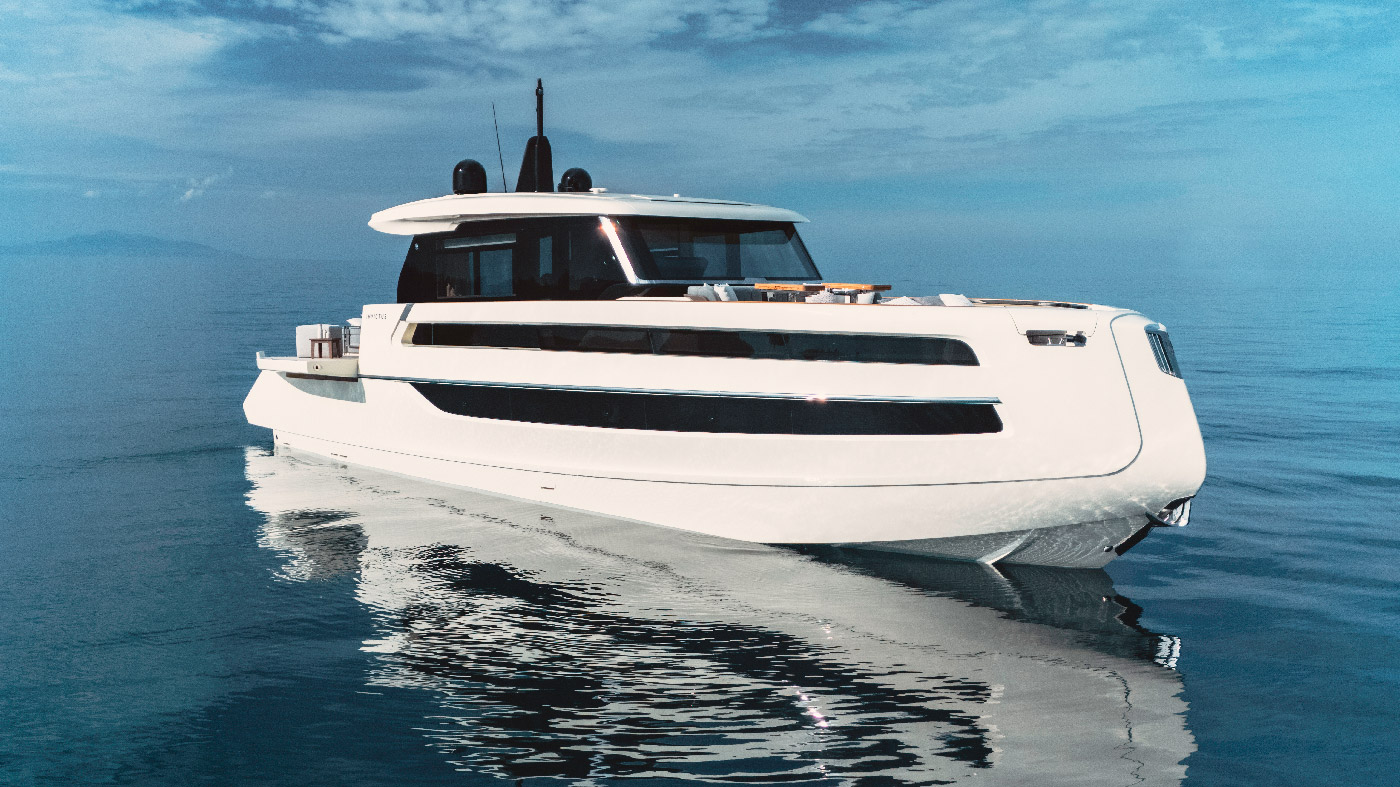The main function of article titles is to draw readers’ attention. Although not deceptive, they generally include a little bit of stretch. However, in the case of the Benetti Fast 125 sea trial, the stretch is actually minimal. We tested the responsiveness of this yacht directly at sea when her 197 tons, pushed at the 22-knot top speed, seemed to disappear as soon as we touched the wheel in a tight left turn. The response of the hull was immediate and it progressively allowed us to intercept the waves raised by the wake the Benetti generated along her course.

Of course, handling is not the major quality required on a 38-metre recreational yacht featuring a beam of over 8 metres. However, perhaps for this very reason, this yacht astonishes when it shows such a natural handling during a sea trial experience like that we enjoyed along the shoreline of Viareggio.
More specifically, what we tested is the third hull of the Benetti Yachts Fast series whose delivery to the American owner is due to take place in about one month. Meanwhile, hull number 7 of the Fast 125 series is currently under construction in the Benetti’s Viareggio-based production site.
Hull lamination process and fitting are expected to take about three and 18 months respectively, at least according to the lead time Andrea Moschese, Benetti Yachts Product Manager, gave us when he explained that the shipyard’s production capacity for this model is of two hulls a year.

The boat
This third hull includes some very interesting characteristics. The first of them concerns the upper decks, or better, the materials which they are made of. The two superstructures are indeed made of carbon and epoxy resin, a choice which has allowed a 40% reduction in their weight. For example, the second superstructure (the highest one) weights just 4,000 kg. It’s so light that, during the implementation process in the rest of the hull, wind provoked a number of difficulties. The perfect hull-deck connection is another key element of this yacht. Superstructures are, in fact, joined to the hull and to each other by the use of glues. No screw has been employed, in line with the aim of save weight in the upper parts.
Another essential factor concerns the hull. Like the other models of the Fast 125 series, the Skyler, too, has a D2P (Displacement to Planing) hull, equipped with a wave-piercer bow, specifically designed to combine the advantages of a displacement hull at low speeds with those of a planing hull at high speeds providing with great hydrodynamic efficiency and considerable fuel saving.

Now, let’s deal with what is probably the most interesting element offered by this yacht: the Azipull Carbon 65 propulsion system. Specifically designed and developed by Rolls-Royce for the Benetti Fast 125 series, it’s a new generation system aimed for fast yachts with a typical size of 100-150 feet which implies many advantages. First of all, composite materials have substantially reduced the propulsion system’s weight: the weight of the inboard part is approximately 1,150kg while the weight of the underwater part is approximately 1,650kg including propellers. This innovation has also allowed for a better vessel layout with larger volumes in the astern garage along with excellent manoeuvring capabilities both in navigation and while docking.
Exteriors

Exterior design of this yacht preserves the same lines of the previous models. The Skyler has sporty streamlined lines especially in the bow section where the Italian designer Stefano Righini has used long horizontal windows.
Equipped with a wet bar, the astern swimming platform suggests the idea of a separate independent area. The laterally opening garage leaves the aft area free for guests by creating a first living deck.
The lower deck immediately makes clear the concept of the exterior layout. The idea was to create four distinct areas devoted to the sea and on-board living and a sort of path through such different environments which seem to suggest completely different on-board lifestyles.
Lateral stairways lead to a first exterior deck which, in its turn, gives access to the saloon. This area is furnished with a large sofa facing a low coffee table and two armchairs. This space leads to the upper deck, where the owner asked for a large handcrafted teak dining table decorated with glass and steels details.
The sun deck above is equipped with a wet bar, some sofas and a large luxurious dinette. The arrangement and size of all these environments and their furniture create different, although consistent, atmospheres within the same area which make guests live different experiences on board.
Another area for relaxing, equipped with a pool, is positioned in the large bow section, on the same level of the pilot’s house.
Interiors
A strong synergy between Benetti’s in-house design department and Redman Whiteley Dixon has generated the interior design concept in terms of architecture, materials – thai wood, ebony, Tanganyika frisé wood, glossy nichel details and a variety of leathers – and technological solutions, such as the care in preventing both furniture and carbon used for superstructures from coming into reciprocal contact and the use of special insulating materials to avoid vibrations. If this is the heart and philosophy of the project, the owner has also required some typically American elements and details for his yacht.

Guest cabins – three double ones and one with twin beds – are all located on the lower deck and benefit from a breath-taking view on the sea. Each cabin has different coloured leather ceiling and is equipped with an en-suite bathroom and furnished with luxurious materials, such as ebony and Tanganyika wood.
The full-beam elegant owner’s cabin is on the main deck. It’s a real suite, equipped with armchairs and walk-in closets. The two en-suite bathrooms – one with shower box and the other with bathtub – are entirely lined in onyx. Lateral windows become two spectacular balconies through an opening mechanism which can be operated by remote.

Three distinct cabins in the bow section are reserved for crew members. On the main deck, the saloon is especially bright and luminous thanks to its floor-to-ceiling windows and a generous use of glass that let natural light flood into the light-toned space. In the middle, a large dining table, located next to the galley, can seat ten people. Next to the entrance of the pilot’s house there’s another relaxing area equipped with a gym and a spa.
Sea trial
The typical emotion of the great – equally funny – events is in the air at the quay in Viareggio. The Skyler has to board 34 passengers in total. Most of them are journalists coming from all around the world. Once boarded, the test starts even before sailing off with a tour guided by Andrea Moschese. The aim is to explain the technological and creative effort underlying the project and the two-year work of Benetti’s staff in order to give a frame to a painting whose beauty would otherwise risk remaining abstract. The yacht is the clear expression of the thoughts, eyes and hands through which boat industry manages to create and combine ideas with design accuracy.
When the captain drives this Benetti 38-metre yacht out of the narrow channels in the port of Viareggio by the simple use of the joystick, we hardly realize that we’re moving: vibrations are totally absent to the advantage of silence and fluidity.

Once at sea, the two MTU (12V 2000 M94) 2,636 hp diesel engines deploy their quiet power. We’re in the pilot’s house, where we hardly manage to appreciate the sense of speed because of an almost total silence. At 1,600 engine revolutions, the yacht already sails at 14 knots. Progression in water is linear, as obvious on a yacht of this size. At 2,000 revolutions, cruising speed reaches 16.3 knots. The hull gives an extraordinary sensation of stability even at top speed (21.8 knots at 2,450 revolutions).
However, it’s during a tight left turn that the agility of the Benetti 125 Fast astonishes everyone. Although justified by the propulsion system, responsiveness is amazing. Unlike traditional in-line propulsion systems, i-pods are incredibly more responsive. However, these performances are made possible not only by the Azypull Carbon 65 but also by the hull design, which follows the thrust of the two engines.
With 30,000 litre fuel capacity, the yacht has a maximum range of about 1,500 nautical miles at 12 knots. The pleasure of sailing on a recreational ship featuring the same agility as an open boat is guaranteed for three days.
Conditions of the sea trial. The test has been carried out along the shoreline of Viareggio, on flat sea and windless day with half-full water and fuel tanks and 34 passengers on board.
Technical Specifications
| Length overall | 38.1m / 125’ |
| Beam max | 8.45m / 27’ 9″ |
| Draft max | 2.08m / 6’ 9″ |
| Full Load Displacement | 197 tons |
| Fuel tank capacity | 25.000 l |
| Fresh water capacity | 4.000 l |
| Owner & Guests cabins | 10 persons in 5 cabins |
| Crew cabins | 7 persons in 4 cabins |
| Main engines | 2 X MTU 12V 2000 M94 2,636hp diesel engines |
| Propulsion system | 2 x Rolls Royce Azipull 65C |
| Generators | 2 x Kohler 80kW |
| Bow thruster | CMC Marine electric thrusters |
| Stabilizers | CMC Marine electric fin stabilizers |
| Velocità massima / Max speed | 22 nodi / knots |
| Range @ 12 kn | 1.750 nm |
| Classification | RINA |
| Builder | Benetti |
| Naval Architecture | Benetti Technical Department |
| Concept + Exterior designer | Stefano Righini |
| Interior designer | Redman Whiteley Dixon |
Performances
2 MTU (12V 2000 M94) 2.636 hp diesel engines
| Rpm | Speed (knots) | Fuel consumption (l/h) |
| 1400 | 12.5 | 128 |
| 1600 | 13.8 | 280 |
| 1800 | 14.9 | 400 |
| 2000 | 16.3 | 585 |
| 2200 | 18.3 | 740 |
| 2450 | 21.8 | 970 |


























One Response
This is perfect yacht.if i am not wrong she was in lusben shipyards.l saw her there.